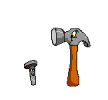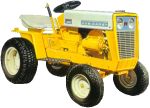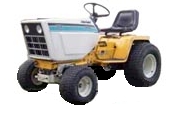
 |
PLEASE PATRONIZE OUR SPONSORS!






|
|||||||
 |
|
|
Thread Tools

|
Display Modes

|
|
#11
|
||||
|
||||
|
Quote:
The by product of the lead is it created a layer of lead on the valve seats to cushion the valves and it retains its octane for years IE it doesn't go bad. I have left avg as in a motor unstarted for 2 years and it started right up. The bad is avg gas is expensive now $5-7 a gal normally some times cheaper. Oh and lead will kill you well over time. EDIT: Any one ever put some spray or a small turbo on one of these motors? I guess it wouldn't matter on a hydrostat as it only spins x speed to get X pressure? |
|
#12
|
||||
|
||||
|
Beside bigging up the rears, more pressure in front tires if handling is not factor. Reason...less roll resistance.
__________________
Two 125's and a 124 all with 42" decks Plow blade #2 Cart QA36 snowthower |
|
#13
|
|||
|
|||
|
Quote:
The purpose of lead wasn't to cushion the valves..... it was to lubricate them. When you say "spray" I assume you mean nitrous? No.... it would blow it apart. A turbo? No, it would blow it apart... motor is not meant for boost unless you beef it up. I'm not sure you understand the principals of the hydro trans. It would matter, as in X speed. Pressure is regulated, so it won't change with speed. Run the hydro faster, the output will be faster, just like any other trans. Pressure doesn't really affect speed. It's just a hydraulic pump driving a hydraulic motor.... faster input = more flow. More flow= more speed. |
|
#14
|
||||
|
||||
|
Quote:
Quote:
Quick google search brings up some performance parts and even billet head and decent looking bottom end parts for K motors. And surprisingly a blow err supercharged K motor.   Oh and If money is an issue then neither of the power adders is recommend. lol Quote:
|
|
#15
|
|||
|
|||
|
As stated numerous times here, several different ways, the governed engine speed is the determining factor in how fast that tractor will run under NO LOAD.
If you're running a steep hill, pulling a load or otherwise can't bump the governor, twice the horsepower will not make you run any faster. |
|
#16
|
|||
|
|||
|
Quote:
Quote:
Quote:
|
|
#17
|
|||
|
|||
|
I'm a little late getting here and this would be difficult to do with the fender pan on your 129...
I saw some pictures one time several years ago of a fellow at a similar race who put the big diamond tread wheels and tires from a lo boy on an Original to increase his ground speed. It looked kinda dangerous to me.
__________________
More IH Cub Cadet Parts RIGHT HERE |
|
#18
|
||||
|
||||
|
Quote:
 It amazes me how many misunderstand this. The partially burnt fuel stays behind as carbon build up, thus increasing compression, making it ping when don't use high octane. It amazes me how many misunderstand this. The partially burnt fuel stays behind as carbon build up, thus increasing compression, making it ping when don't use high octane. It costs more, it must be better.  Edit: I didn't see the second page. Need more 
__________________
Travis 1993 Cub Cadet 2064 1988 Cub Cadet 2072 1980 IH Cub Cadet 782 w/CH20 1966 IH Cub Cadet 102 w/K301 1961 IH Cub Cadet O 1967 IH Cub Cadet 102 & 122     JD 2155 w/ 175 loader |
|
#19
|
||||
|
||||
|
The way they used to explain it to us was:
Low octane fuel burns fast in the combustion chamber and it is possible to have 2 flame fronts in the combustion chamber due to heat/compression, and when they meet/collide during compression, it produces knock and piston destruction ( BTDT) Higher octane burns slower allowing for more controlled burn with no knock or engine damage. Tetraethyl lead increased octane and lubricated the valves/seats for longer life. @ least that is what they taught us back in the day. -------But lead caused Cancer in the state of Mexifornia so it was a removed 
|
|
#20
|
||||
|
||||
|
Quote:
HOWEVER Why does the owners manual say to use 89 Octane or above? Was much lower octane available back in the ole days that someone may have used TOO low octane? I'm not arguing against the uselessness of higher octane in a low combustion engine, just curious why IH would say to use 89 Octane?
__________________
-Jason Cub Cadets: 1200 | 149 | 1650 | 122 | Z-Force S 54 Implements: QA42A | Push Blades | #2 Tiller | Rear Blade | 223A Utility Trailer | And a few mower decks Gravelys 5260 | CI Walk-behind (Project) And a couple of Subarus 
|
 |
|
|
Cub Cadet is a premium line of outdoor power equipment, established in 1961 as part of International Harvester. During the 1960s, IH initiated an entirely new line of lawn and garden equipment aimed at the owners rural homes with large yards and private gardens. There were a wide variety of Cub Cadet branded and after-market attachments available; including mowers, blades, snow blowers, front loaders, plows, carts, etc. Cub Cadet advertising at that time harped on their thorough testing by "boys - acknowledged by many as the world's worst destructive force!". Cub Cadets became known for their dependability and rugged construction.
MTD Products, Inc. of Cleveland, Ohio purchased the Cub Cadet brand from International Harvester in 1981. Cub Cadet was held as a wholly owned subsidiary for many years following this acquisition, which allowed them to operate independently. Recently, MTD has taken a more aggressive role and integrated Cub Cadet into its other lines of power equipment.
This website and forum are not affiliated with or sponsored by MTD Products Inc, which owns the CUB CADET trademarks. It is not an official MTD Products Inc, website, and MTD Products Inc, is not responsible for any of its content. The official MTD Products Inc, website can be found at: http://www.mtdproducts.com. The information and opinions expressed on this website are the responsibility of the website's owner and/or it's members, and do not represent the opinions of MTD Products Inc. IH, INTERNATIONAL HARVESTER are registered trademark of CNH America LLC
All material, images, and graphics from this site are the property of www.onlycubcadets.net. Any unauthorized use, reproductions, or duplications are prohibited unless solely expressed in writing.
Cub Cadet, Cub, Cadet, IH, MTD, Parts, Tractors, Tractor, International Harvester, Lawn, Garden, Lawn Mower, Kohler, garden tractor equipment, lawn garden tractors, antique garden tractors, garden tractor, PTO, parts, online, Original, 70, 71, 72, 73, 76, SO76, 80, 81, 86, 100, 102, 104, 105, 106, 107, 108,109, 122, 123, 124, 125, 126, 127, 128, 129, 147, 149, 169, 182, 282, 382, 482, 580, 582, 582 Special, 680, 682, 782, 782D, 784, 800, 805, 882, 982, 984, 986, 1000, 1015, 1100, 1105, 1110, 1200, 1250, 1282, 1450, 1512, 1604, 1605, 1606, 1610, 1615, 1620, 1650, 1710, 1711, 1712, 1806, 1810, 1811, 1812, 1912, 1914.